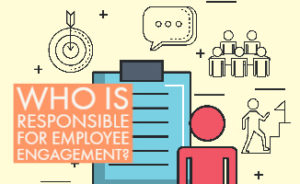Who Is Responsible for Employee Engagement? Employer? Employee? Hint: EVERYONE
Low engagement levels can cause a spiral of negative effects in the workplace. Between lower productivity levels, more frequent accidents, and higher absenteeism, employees that aren’t engaged in their jobs or the organization can lead to weaker bottom line. When employees are not engaged, you’ll witness higher turnover, a poor work environment, and an influence on the engagement level of your clients or customers.
Employees who are engaged are:
- Enthusiastic about their work
- Positive toward the organization
- Collaborative with colleagues
- Looking for ways to improve themselves or the organization
Who is responsible for employee engagement? It’s not just up to the employees. Or managers. Or CEOs. Employee engagement is a team effort. Let’s take a look at the different roles in employee engagement in the workplace.
Employee
Engagement starts with the individual. An employee is responsible for their own level of engagement. As an employee, try the following to improve your experience.
- Evaluate your relationship with your job and organization. What do you love? What do you wish would change? Knowing what’s keeping you from being fully engaged is the first step to working towards an improvement.
- Act with intent. Do your best to have a good morning. Start preparing for work the night before so you can walk out the door in the morning on time and stress-free. Listen to a motivational podcast on the way to work. Spend a few minutes focusing on how you’ll complete your work before you walk in the door. And then, spend your first 60 minutes focusing on your most difficult tasks (when you have the most energy) so you can complete the day with more purpose.
- Recharge outside of the office. When you’re not at work, are you taking care of yourself? Don’t underestimate the power of a good diet, an exercise routine, and a great night’s sleep. Take vacation time when appropriate (even if it’s just a staycation) and enjoy time spent with family and friends. And when you’re at work, take a lunch break! Studies show that 81% of employees who take a lunch break have a strong desire to be active in their place of employment.
Management
Employees crave and need support from management. Managers control an employee’s work environment. If you’re responsible for just a few employees or a large group, consider the following tips for boosting your team’s engagement.
- Be an open book. Share your vision and goals for an engaged workplace. If employees don’t know your intent, they’ll assume you’re happy with the current work environment, especially if it’s negative.
- Make engagement a priority from start to finish. This means bringing it up in a candidate’s initial interview, discussing it during one-to-one meetings, and talking it over during exit interviews. Knowing why talent wants to work at your company, understanding how they feel on a daily basis, and learning why they’re moving on will help you improve engagement levels.
- Give and accept feedback. Employees need to know when their performance is slacking (and when it’s at a rockstar level). At the same time, listen to employee suggestions for a better workplace. This could include workplace contests, unique rewards, or a group outing. If a suggestion makes sense and fits without workplace guidelines, give it a try!
Senior Level
Senior level management, including CEOs, can make a significant impact when it comes to employee engagement. Here are a few tips and suggestions to consider.
- Don’t be a ghost. Senior level team members shouldn’t be mysterious strangers to ground floor employees. If you’re a CEO who spends 90% of your time in your office, spend more time one-on-one with your employees. If your schedule truly doesn’t allow you to do this, send out weekly or monthly memos, written by you and not your assistant, that share your goals and observations from your level. Allow your employees to know who you are, one way or another.
- Look past your own desk and to-do list. Employee issues are your issues too. If there’s frustration or concern within the organization, put forth effort into resolving it. Whether you assign a manager or handle the issue yourself, show that you’re invested in creating a harmonious work environment.
- Understand the numbers. If you’re just working on improving employee engagement because you think you’re supposed to, you won’t get the results you’re after. Instead, understand that companies who have higher engagement are 21% more profitable or experience 41% less absenteeism. Explore the benefits of engagement until you find your own motivation and understanding of just why engagement is so important.
Engagement — A Team Effort
So, who is responsible for employee engagement? Engagement doesn’t happen by accident; it truly is a team effort.
When everyone does their part to inspire and promote engagement, there are benefits on every level. No matter your role, be intentional and you’ll see results.
Tandem HR is an IRS Certified Professional Employer Organization (CPEO) providing hundreds of businesses with high-touch and custom HR solutions. We provide payroll, benefits, risk management, employee relations and much more.
If you have any other questions, please reach out to us at 630.928.0510 or fill out the form below and one of our Business Development Managers will contact you.
Share this blog post on:

